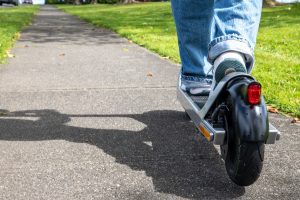Riding on scooters, from kick ones to electric scooters, offers a unique blend of thrill and convenience. But, like all things, our scooters and their parts require regular maintenance. Among these parts, our scooter pads demand special attention. Over time, they accumulate dirt, which could compromise their efficiency and safety. Cleaning of brake pads ensures they remain at peak performance, offering both comfort and stability.
We are firm believers in prioritizing safety. So, for those looking to maintain or even improve the longevity of their gear, we’ve crafted this straightforward guide on cleaning brake pads. From selecting the right cleaning materials to establishing a consistent cleaning routine, we’ve got it covered. By taking care of these essentials, you can revel in the feel of fresh, clean gear and ensure a safe scooter riding experience.

To protect your scooter pads effectively, gather essentials like a damp cloth, soap, and a brush. Start by removing the pads and washing them thoroughly, focusing on details like corners where dirt might accumulate. After washing, ensure they are completely dry before reattaching them to your scooter. Regular cleaning not only extends the pads’ life but also enhances your scooter’s overall performance. So, the next time you hop on your e scooter, remember the value of clean and well-maintained pads. Stay safe and happy riding!
Key Takeaways
We’ve walked you through the process of cleaning your scooter brake pads, and we hope it’s clear now. It’s not just about keeping them looking good but also ensuring they’re safe to use. Regular cleaning and maintenance can extend their lifespan significantly, so don’t wait until they’re grimy or worn out – make this simple routine a part of your regular care for your scooter.

We prioritize safety and believe the family unit should value it too. We want to help you maintain your brake pads, the grip, and the brakes. Each of them has attributes and values to consider when cleaning them, such as using a non-abrasive cloth and detergent.
It’s important to remember that this content is not for gas-powered scooters. By taking the time to follow this simple maintenance process, you’ll be sure to have a safe and happy scooting experience.
We truly value your input and feedback about this article, so please feel free to share your experience in the comments below. Happy scooting!
Importance Of Cleaning Brake Pads
Riding an electric scooter is not just about convenience but also about ensuring its longevity and safety. For those who prioritize the safety of their family, maintaining the cleanliness of brake pads becomes paramount. They are crucial as they not only contribute to a comfortable ride but also play a vital role in the safety of the rider.
Dirty brake pads can compromise the deck’s grip, affecting balance and control. Moreover, neglected hygiene can lead to health concerns, especially if the scooter is a shared family item. Apart from the deck, it’s essential to keep components like the disc rotor and fenders clean and functional.
To maintain and deliver the best scooter riding experience, gather your cleaning essentials: liquid soap, a soft cloth, and an all-purpose cleaner. When choosing products, always choose ones that are suitable for the specific material. Regular cleaning and maintenance not only ensure a safer ride but also enhance the overall performance. Prioritizing hygiene is an investment in safety and durability.
Gather Cleaning Materials
Gathering the necessary materials is an essential first step toward maintaining the freshness and longevity of our scooters. Here at FamilyHype, we understand the importance of sustainability and cleanliness when it comes to scooter care. Together, we can select materials that’ll gently yet effectively clean our brake pads.
- Material selection: soft cloth or sponge
- Mild detergent
- Natural Cleaners: vinegar and baking soda
By gathering the necessary materials and using natural cleaners, we can ensure that our scooters stay fresh and healthy. Let’s move smoothly into examining our gear for pre-clean inspection and dusting.
Having the right cleaning materials is essential for maintaining your scooter’s pristine appearance. When cleaning your electric scooter, always check for the appropriate cleaning products, utilize water sparingly, and follow recommended tips to ensure it looks as good as new.
Pre-Clean Inspection And Dusting
Before cleaning, it’s essential that we inspect them for wear and tear and dust off any surface grime. Doing this will help prevent dirt from being ground deeper into the brake pads in the course of cleaning.

The main topic of this article is about scooters and pre-clean inspection and dusting. This includes examining parts such as tires, brakes, and motors, as well as brushing off dirt, dust, and debris. To ensure the best deep cleaning process, it’s important to take these steps first.
We hope you find this information helpful and informative.
Deep Cleaning Process
Diving right into the deep cleaning process for electric scooters, it’s crucial to know just how beneficial this can be for extending the life and efficiency of your ride. Focus on battery scooters and attributes such as size, power, and range. Implement stain removal techniques, using odor elimination methods, regularly inspecting for wear and tear, replacing worn-out parts promptly, and keeping a consistent cleaning schedule. This level of care ensures your brake pads remain in top-notch condition.
Drying Brake Pads
So, you’ve finished the deep clean – now let’s talk about getting those components thoroughly dry. Proper drying methods are crucial not just for hygiene but also to prolong the lifespan of your brake pads. To prolong the life of your scooter’s brake pads and ensure optimal performance, regularly check the pads for wear and dry them thoroughly after cleaning. Especially for scooters equipped with disc brakes, pay extra attention to drying the pads after cleaning with soapy water, and inspect the folding mechanism to guarantee smooth operation.
It’s important to note that this advice is for non-gas-powered scooters. We recommend air drying in a well-ventilated area or using a low-heat dryer setting. By ensuring each piece is completely dried, we can prevent the growth of mold and mildew.
By following the advice in this article, you can ensure that your brake pads are completely dry and free from mold and mildew. This way, you can maintain a regular maintenance and cleaning schedule, and your scooter will remain in top condition.
Regular Maintenance Schedule
Moving on from drying, let’s focus on creating a regular maintenance and cleaning schedule. This is an essential step for prolonging the lifespan of your ride. Regular checks and cleanups help avoid unnecessary wear and tear, ensuring they serve you effectively for longer. A consistent maintenance frequency not only enhances their performance but also enables us to contribute positively by reducing waste.
For the best care, we recommend weekly or monthly cleaning, checking for any loose parts, and making sure all nuts and bolts are tight. Additionally, make sure to inspect the tires and replace them if necessary. We also suggest lubricating the chain and checking the brakes to ensure safety and smoothness.
Lastly, be sure to store your scooter in a dry, secure place.
Conclusion
We’ve walked you through the process of cleaning your brake pads, and we hope it’s clear now. It’s not just about keeping them looking good but also ensuring they’re safe to use.
Regular cleaning and maintenance can extend their lifespan significantly, so don’t wait until they’re grimy or worn out. Make this simple routine a part of your regular care for your scooter. Maintenance should include the brake pads, the grip, and the brakes. Cleaning them with a non-abrasive cloth and detergent. By taking the time to follow this simple maintenance process, you’ll be sure to have a safe and happy scooting experience.
Frequently Asked Questions (FAQs)
How Often Do You Need To Change The Brake Pads Of Your Scooter?
The frequency of changing brake pads largely depends on usage and riding conditions. Typically, pads require changing every 3,000 to 7,000 miles, but it’s essential to regularly inspect them for wear. If the pad’s thickness is below 2mm or they make squeaking noises, it’s time for a replacement. Always refer to the manufacturer guidelines for specific recommendations.
What Is The Best Way To Clean Brake Pads?
Cleaning brake pads requires caution to maintain their efficacy. Use a brake cleaner spray, available at automotive stores, to spray onto the pads and rotor, ensuring you remove dirt and brake dust. Wipe them down with a clean cloth, and always wear gloves to prevent oil from your hands from contaminating the pads. Avoid using general-purpose cleaners, as they might compromise the pads’ performance.
How Often Do You Need To Clean Your Scooter?
Cleaning frequency depends on your scooter’s usage and environment. If used daily in urban areas or in rainy conditions, weekly cleaning is beneficial. However, for less frequent use or cleaner environments, bi-weekly or monthly cleanings might suffice. Regular cleaning not only keeps the scooter looking good but also helps in spotting potential issues early on.
How Can I Make My Scooter Glide More Smoothly?
Ensuring a smoother ride involves regular maintenance. Keep tires properly inflated, lubricate all moving parts, and regularly inspect the suspension and brakes for wear. Clean the scooter regularly to remove grime that could affect performance. If you notice any issues, address them promptly or seek a professional’s assistance.
How Often Should Brake Pads Be Serviced?
Regularly inspecting brake pads is crucial, ideally every 500 to 1,000 miles. Servicing doesn’t always mean replacement; sometimes, they might just need cleaning or realignment. Addressing any squeaks, reduced braking power, or unusual noises promptly ensures the brake system remains effective. Always prioritize brake maintenance for safety.
Is It Important To Change Brake Pads?
Absolutely, they are vital for scooter operation. Worn-out brake pads can lead to longer stopping distances and potential accidents. Regularly inspecting and replacing them when worn ensures optimal braking performance. Not changing worn pads can also cause more expensive damage to brake rotors and other components.
How Far Should Brake Pads Last?
Brake pad lifespan varies based on riding conditions and brake usage. On average, brake pads last between 3,000 to 7,000 miles. It’s essential to regularly check their thickness and overall condition. Always replace them if they reach a thickness below 2mm or show uneven wear.
How Do You Clean Scooter Brakes?
To clean the brakes, first, ensure the scooter is stable. Use a specialized brake cleaner spray, spraying it onto the brake components. This removes accumulated brake dust and grime. Wipe with a clean cloth and allow to dry. Avoid touching the cleaned parts with oily hands to prevent contamination.
What Is The Best Way To Clean Your Scooter?
Use a mild detergent mixed with water. Begin by rinsing the scooter to remove loose dirt. Then, using a soft cloth or sponge, gently scrub the surfaces. Clean grimy corners. Rinse and dry.
What Is The Best Lubricant To Use For Scooters?
A high-quality, lightweight synthetic lubricant is ideal. It’s essential to use lubricants specifically designed for scooters or similar vehicles. Apply to all moving parts, including the chain or belt, pivot points, and cables. Proper lubrication reduces wear, ensures smooth operation, and prolongs the scooter’s lifespan. Always refer to the manufacturer’s recommendations for specific lubricant types.
DISCLAIMER (IMPORTANT): This information (including all text, images, audio, or other formats on FamilyHype.com) is not intended to be a substitute for informed professional advice, diagnosis, endorsement or treatment. You should not take any action or avoid taking action without consulting a qualified professional. Always seek the advice of your physician or other qualified health provider with any questions about medical conditions. Do not disregard professional medical advice or delay seeking advice or treatment because of something you have read here a FamilyHype.com.